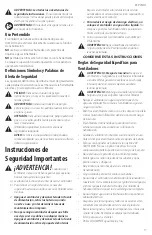
5
English
•
NEVER force the battery pack into the charger. DO
NOT modify the battery pack in any way to fit into a
non‑compatible charger as battery pack may rupture
causing serious personal injury.
Consult the chart at the
end of this manual for compatibility of batteries and chargers.
•
Charge the battery packs only in
CRAFTSMAN chargers.
•
DO NOT
splash or immerse in water or other liquids.
•
DO NOT
allow water or any liquid to enter battery pack.
•
Do not store or use the tool and battery pack in
locations where the temperature may reach or
exceed 104 °F (40 °C) (such as outside sheds or metal
buildings in summer).
For best life store battery packs in
a cool, dry location.
NOTE: Do not store the battery packs in a tool with
the trigger switch locked on. Never tape the trigger
switch in the ON position.
•
Do not incinerate the battery pack even if it is severely
damaged or is completely worn out.
The battery pack
can explode in a fire. Toxic fumes and materials are created
when lithium‑ion battery packs are burned.
•
Do not expose a battery pack or appliance to fire or
excessive temperature.
Exposure to fire or temperature
above 265 °F (130 °C) may cause explosion.
•
Follow all charging instructions and do not charge the
battery pack or appliance outside of the temperature
range specified in the instructions.
Charging improperly or
at temperatures outside of the specified range may damage
the battery and increase the risk of fire.
•
If battery contents come into contact with the skin,
immediately wash area with mild soap and water.
If
battery liquid gets into the eye, rinse water over the open
eye for 15 minutes or until irritation ceases. If medical
attention is needed, the battery electrolyte is composed of a
mixture of liquid organic carbonates and lithium salts.
•
Contents of opened battery cells may cause
respiratory irritation.
Provide fresh air. If symptoms
persist, seek medical attention.
•
Battery liquid may be flammable if exposed to spark
or flame.
•
Never attempt to open the battery pack for any
reason. If the battery pack case is cracked or
damaged, do not insert into the charger.
Do not crush,
drop or damage the battery pack. Do not use a battery pack
or charger that has received a sharp blow, been dropped,
run over or damaged in any way (e.g., pierced with a nail,
hit with a hammer, stepped on). Damaged battery packs
should be returned to the service center for recycling.
Storage Recommendations
The best storage place is one that is cool and dry, away
from direct sunlight and excess heat or cold. Store the fully
charged battery pack out of the charger.
Battery Pack Cleaning Instructions
Dirt and grease may be removed from the exterior of the
battery pack using a cloth or soft non-metallic brush. Do not
use water or any cleaning solutions.
READ ALL INSTRUCTIONS
Important Safety Instructions for All
Battery Packs
WARNING:
Read all safety warnings, instructions,
and cautionary markings for the battery pack,
charger and product. Failure to follow the
warnings and instructions may result in electric
shock, fire and/or serious injury.
•
Do not charge or use the battery pack in explosive
atmospheres, such as in the presence of flammable
liquids, gases or dust.
Inserting or removing the battery
pack from the charger may ignite the dust or fumes.
BATTERIES AND CHARGERS
The battery pack is not fully charged out of the carton.
Before using the battery pack and charger, read the
safety instructions below and then follow charging
procedures outlined. When ordering replacement battery
packs, be sure to include the catalog number and voltage.
The label on your tool may include the following symbols. The
symbols and their definitions are as follows:
V ......................... volts
Hz .......................hertz
min .....................minutes
or DC ......direct current
...................... Class I Construction
(grounded)
…/min ..............per minute
BPM ....................beats per minute
IPM .....................impacts per minute
OPM .................... oscillations per
minute
RPM .................... revolutions per
minute
sfpm ................... surface feet per
minute
SPM ....................strokes per minute
A .........................amperes
W ........................watts
Wh ......................watt hours
Ah .......................amp hours
or AC ...........alternating current
or AC/DC .... alternating or direct
current
...................... Class II Construction
(double insulated)
no .......................no load speed
n .........................rated speed
PSI....................... pounds per square
inch
......................earthing terminal
.....................safety alert symbol
..................... visible radiation
do not stare into
the light
..................... wear respiratory
protection
..................... wear eye protection
..................... wear hearing
protection
..................... read all
documentation
..................... do not expose to
rain
• Avoid placing where water could collect on surface
creating a slipping hazard.
• Never place the unit near switches or electrical outlets.
• Verify that all connections are secure to this misting fan
before operating
• Use caution while using in windy conditions. Winds may
carry mists into electrical wiring.
• Do not kink or overbend the intake tube.
• Be careful not to spill any water when filling water bucket.
• Ensure all hose connections are secure before using misting
fan. Spilled water and leaks can result in a slippery surface
and create a slip and fall hazard.
Содержание CMCE003
Страница 5: ...3 Fig H Fig I Fig J Fig K 3 4 10 5 5 7 ...
Страница 27: ......








































